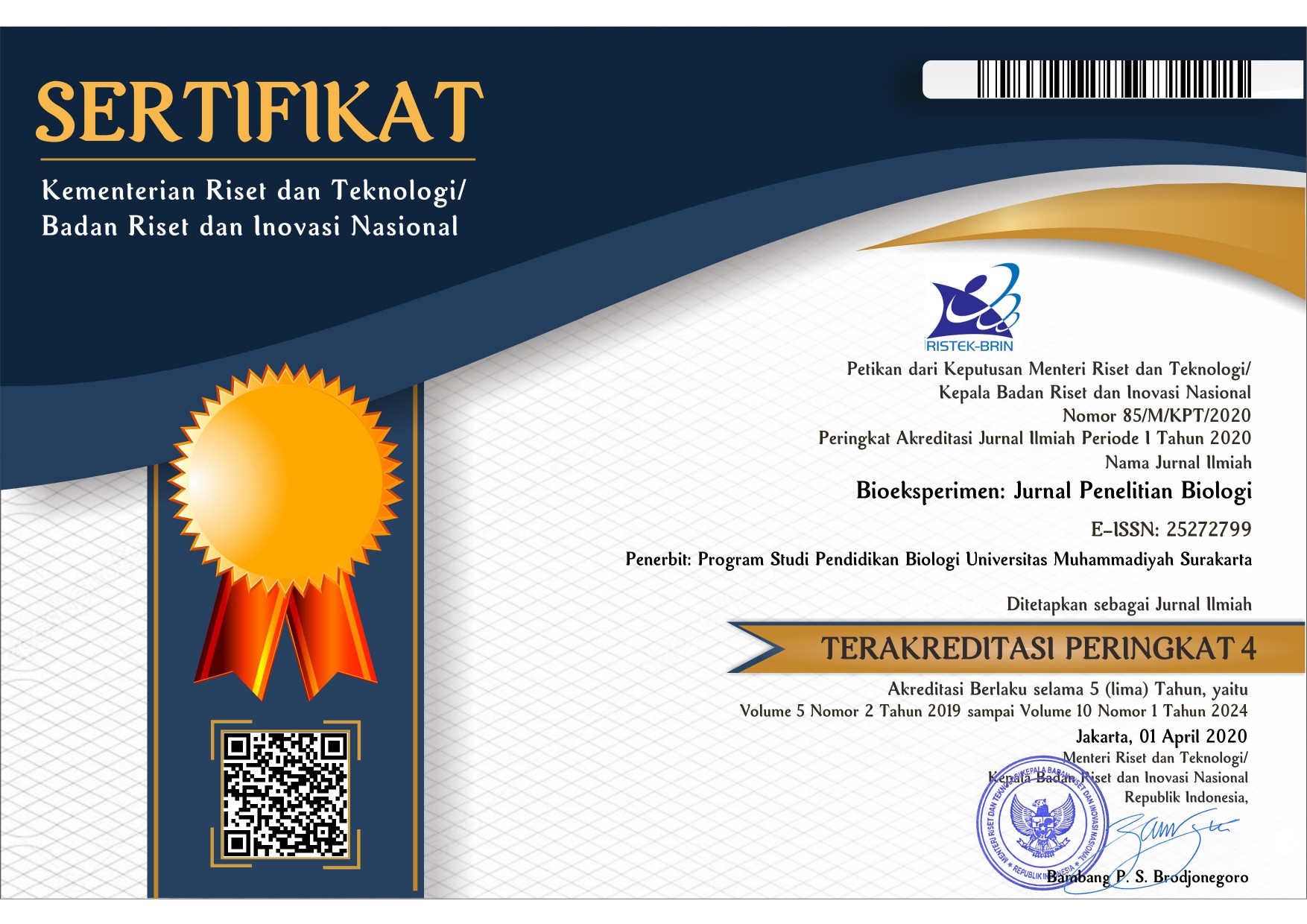Efek Penambahan Limbah Lokal Jerami Dan Sekam Padi Bagi Pertumbuhan Jamur Tiram Putih (Pleurotus ostreatus)
Afifah Nur Shobah(1*), Swastika Oktavia(2)(1) Jurusan Farmasi, Sekolah Tinggi Ilmu Kesehatan Salsabila
(2) Program Studi Biologi, Fakultas Sains, Farmasi dan Kesehatan, Universitas Mathl’ul Anwar
(*) Corresponding Author
Abstract
Keywords
Full Text:
PDFReferences
Amalia, L., Budiasih, R., & Samsul, A. (2018). Pengaruh posisi bukaan plastik baglog dan konsentrasi pupuk fosfor terhadap pertumbuhan dan hasil jamur tiram putih (Pleurotus ostreatus). Kultivasi, 17(1). Retrieved from http://jurnal.unpad.ac.id/kultivasi/article/view/16075
Amuneke, E. H., Dike, K. S., & Ogbulie, J. N. (2011). Cultivation of Pleurotus ostreatus : An edible mushroom from agro base waste products. J. Microbiol. Biotech. Res., 1(3), 1–14.
Ashraf, J., Ali, M. A., Ahmad, W., Ayyub, C. M., & Shafi, J. (2013). Effect of Different Substrate Supplements on Oyster Mushroom (Pleurotus spp.) Production. Food Science and Technology, 1(3), 44–51. https://doi.org/10.13189/FST.2013.010302
Astuti, H., Astuti, H. K., & Kuswytasari, N. D. (2013). Efektifitas Pertumbuhan Jamur Tiram Putih (Pleurotus ostreatus) dengan Variasi Media Kayu Sengon (Paraserianthes falcataria) dan Sabut Kelapa (Cocos nucifera). Jurnal Sains Dan Seni ITS, 2(2), E144–E148. https://doi.org/10.12962/j23373520.v2i2.3955
Carrasco, J., Zied, D. C., Pardo, J. E., Preston, G. M., & Pardo-Giménez, A. (2018). Supplementation in mushroom crops and its impact on yield and quality. AMB Express, 8(1), 146. https://doi.org/10.1186/s13568-018-0678-0
Egra, S., Kusuma, I. W., & Arung, E. T. (2018). Kandungan Antioksidan pada Jamur Tiram Putih (Pleurotus ostreatus). ULIN: Jurnal Hutan Tropis, 2(2). https://doi.org/10.32522/u-jht.v2i2.1549
Facchini, J. M., Alves, E. P., Aguilera, C., Gern, R. M. M., Silveira, M. L. L., Wisbeck, E., & Furlan, S. A. (2014). Antitumor activity of Pleurotus ostreatus polysaccharide fractions on Ehrlich tumor and Sarcoma 180. International Journal of Biological Macromolecules, 68, 72–77. https://doi.org/10.1016/J.IJBIOMAC.2014.04.033
Farhatul Wahidah, B., & Adi Saputra, F. (2015). Perbedaan Pengaruh Media Tanam Serbuk Gergaji dan Jerami Padi Terhadap Pertumbuhan Jamur Tiram Putih (Pleurotus ostreatus). Biogenesis: Jurnal Ilmiah Biologi, 3(1), 11–15. https://doi.org/10.24252/bio.v3i1.560
Hearst, R., Nelson, D., McCollum, G., Millar, B. C., Maeda, Y., Goldsmith, C. E., … Moore, J. E. (2009). An examination of antibacterial and antifungal properties of constituents of Shiitake (Lentinula edodes) and Oyster (Pleurotus ostreatus) mushrooms. Complementary Therapies in Clinical Practice, 15(1), 5–7. https://doi.org/10.1016/J.CTCP.2008.10.002
Jayakumar, T., Thomas, P. A., Sheu, J. R., & Geraldine, P. (2011). In-vitro and in-vivo antioxidant effects of the oyster mushroom Pleurotus ostreatus. Food Research International, 44(4), 851–861. https://doi.org/10.1016/J.FOODRES.2011.03.015
Kalyan, N., & Yadav, K. P. (2013). Cultivation of Pleurotus sajor-caju using different agricultural residues. International Journal of Agricultural Policy and Research, 1(2), 19–23.
Naufala, W. A., & Pandebesie, E. S. (2016). Hidrolisis Eceng Gondok dan Sekam Padi untuk Menghasilkan Gula Reduksi sebagai Tahap Awal Produksi Bioetanol. Jurnal Teknik ITS, 4(2), B109–B113. https://doi.org/10.12962/J23373539.V4I2.11308
Obodai, M., Cleland-Okine, J., & Vowotor, K. A. (2003). Comparative study on the growth and yield of Pleurotus ostreatus mushroom on different lignocellulosic by-products. Journal of Industrial Microbiology & Biotechnology, 30(3), 146–149. https://doi.org/10.1007/s10295-002-0021-1
Pathmashini, L., Arulnandhy, V., & Wijeratnam, R. W. (2009). Cultivation of Oyster Mushroom (Pleurotus ostreatus) on Sawdust. Ceylon Journal of Science (Biological Sciences), 37(2), 177. https://doi.org/10.4038/cjsbs.v37i2.505
Pratiwi, R., Rahayu, D., & Barliana, M. I. (2016). Pemanfaatan Selulosa Dari Limbah Jerami Padi (Oryza sativa) Sebagai Bahan Bioplastik. Indonesian Journal of Pharmaceutical Science and Technology, 3(3), 83. https://doi.org/10.15416/ijpst.v3i3.9406
Pugeg Arya, I. N., Kusmaninga, S., Sutjiatmo, A. B., Sumartini, Y., Nursidah, A., & Narvikasar, S. (2010). The Effect of Laetiporus sp. (Bull. ex Fr.) Bond. et Sing. (Polyporaceae) Extract on Total Blood Cholesterol Level. Biotechnology(Faisalabad), 9(3), 312–318. https://doi.org/10.3923/biotech.2010.312.318
Saidu, M., Salim, M., & Yuzir, M. (2011). Cultivation of oyster mushroom (Pleurotus spp.) on palm oil mesocarp fibre. AFRICAN JOURNAL OF BIOTECHNOLOGY, 10(71), 15973–15976. https://doi.org/10.5897/AJB11.1942
Sharma, S., Yadav, R. K. P., & Pokhrel, C. P. (2013). Growth and Yield of Oyster mushroom ( Pleurotus ostreatus ) on different substrates. Journal on New Biological Reports, 2(1), 3–8.
Sipahutar, D. (2010). Teknologi Briket Sekam Padi. Riau: Balai Pengkajian Teknologi Pertanian (BPTP).
Suparti, S., & Marfuah, L. (2015). Produktivitas Jamur Tiramputih (Pleurotus ostreatus) Pada Media Limbah Sekam Padi dan Daun Pisang Kering Sebagai Media Alternatif. Bioeksperimen: Jurnal Penelitian Biologi, 1(2), 37–44.
Widiwurjani. (2010). Menggali potensi seresah sebagai media tumbuh jamur tiram putih. Surabaya: Unesa University Press.
Widyastuti, N. (2008). Aspek Lingkungan Sebagai Faktor Penentu Keberhasilan Budidaya Jamur Tiram (Pleurotus sp.). Jurnal Teknologi Lingkungan, 9(3). https://doi.org/10.29122/jtl.v9i3.473
Wu, J.-Y., Chen, C.-H., Chang, W.-H., Chung, K.-T., Liu, Y.-W., Lu, F.-J., & Chen, C.-H. (2011). Anti-Cancer Effects of Protein Extracts from Calvatia lilacina, Pleurotus ostreatus and Volvariella volvacea. Evidence-Based Complementary and Alternative Medicine : ECAM, 2011, 982368. https://doi.org/10.1093/ecam/neq057
Yanuartono, Y., Purnamaningsih, H., Indarjulianto, S., & Nururrozi, A. (2017). Potensi jerami sebagai pakan ternak ruminansia. Jurnal Ilmu-Ilmu Peternakan, 27(1), 40–62. https://doi.org/10.21776/ub.jiip.2017.027.01.05
Article Metrics
Abstract view(s): 1160 time(s)PDF: 1257 time(s)
Refbacks
- There are currently no refbacks.








